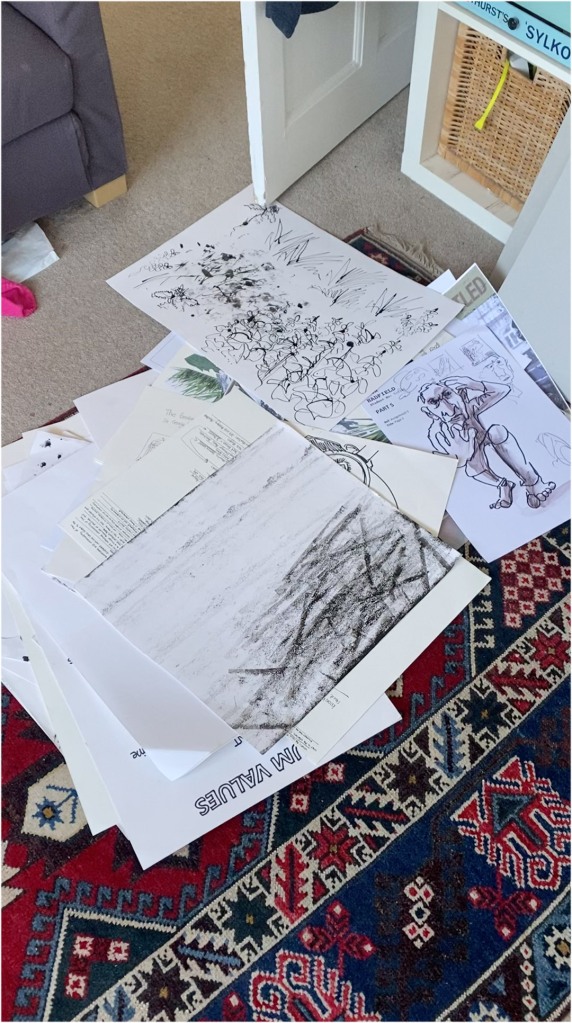The purpose of this research task was to build on the experience of 2.7 Cut-ups, using the same process, but with self-generated source material.
Key words from the brief:
- Generate your own visual material
- Create the following ‘pool’ of images
- Photocopy these at different scales and sizes so that you have several versions of each image
- Working with an A3 format, arrange some of your cut-outs to create 10 composite images
Approach
In the corner of my studio I have a pile of used paper, old sketches and pieces of discarded artwork that I use to cover clean surfaces when I’m spray-mounting or using wet media.
Rather than generate any new source material, I decided to use whatever was in that paper pile as the material for this exercise. It consists of a large variety of material ranging from hand lettering, texture maps, life drawings and recycled artwork going right back to Key steps in illustration.
I started by moving everything down into my kitchen to take advantage of more floor space and a large table top.
I sorted through the paper, categorising it into figures, foreground, background etc., in order to get a feel for what I had to work with.
One of the old pieces of artwork I came across was a 3-page storyboard from the film Apocalypse Now. This included the script that I’d transposed from a film clip. I decided to use this as the source material for a text cut-up, to give me a reworked narrative of some kind as a starting point.
Initial images
The kitchen floor is tiled, and after completing the text cut-up, I laid out the texts across the tiles, using one tile per panel/image. At this point it became clear that the finished work would be a narrative sequence of some kind.
I used the text snippets to suggest imagery, and worked for a couple of hours iteratively creating different pictures for each panel.
At a certain point in time I felt I had enough material to digitise and start more controlled digital composition.
First draft composite images
My initial focus was just on creating individual panels. Initially each panel was identically sized because the images were making themselves i.e I didn’t really have a fully formed idea of composition/size at the start of the process.
During that process I started thinking about what I could do to apply some kind of wholistic visual language across all the images. I tried applying a fairly a heavy texture to the pictures.
I mocked-up a single page consisting of the first four images to get a feel for the story. The texture was too heavy and was dumbing down some of the other visual elements, so I determined to change this during the final iterations of the work.

Final artwork with panel layout
The final stage was the panel layout and design. My usual working process is to work panel layout up in a thumbnail form to a high degree before creating any final artwork. In this case however, the imagery was evolving right through the final artwork, so I was making layout decisions pretty much on the fly.
The final result was a seven panel illustrated sequence across two pages:


Reflections
- Using the paper pile in my studio was a great starting point and highlighted to me that it remains a rich source of material for future use.
- The struggle I had between bringing a level of consistency and control across the imagery was interesting and is in keeping with a tendency I have to not let go. There is a lesson here (again) in just allowing pure experimentation to happen without being overly concerned about the final work. I pulled this back to a large extent in the final artwork.
- I think the panel layout, particularly on page one, makes a huge different to the reading of the images. I was pleased with the diagonal and circular panels.
- Adding a title and subtitle made a big difference to the reading of the panels by providing the reader with additional context.
- In terms of a practical application, I can see that, like 2.6 Word processing, this process is an excellent way to quickly generate a pool of ideas to develop. I would like to think that I could use it as an end in itself but I’m not sure what this would look like.
- I quite like the overall aesthetic of the final artwork, with the use of cutout text rather then speech bubbles and a less refined layout.





















